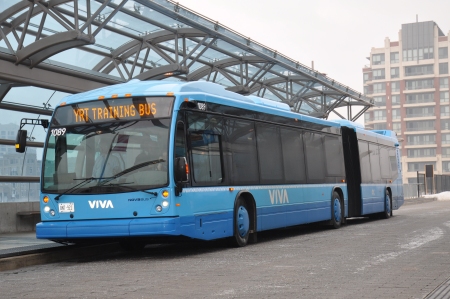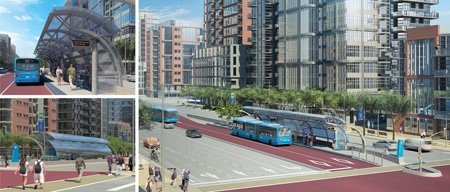
It wasn’t that long ago that vivaNext was listing required specs for new Viva vehicles and testing design ideas for a rapid transit station. It feels like just yesterday that we were deciding station platform widths, highlighting accessibility requirements both on and off Viva and modelling the streetscape of the rapidways.
Now, some of the new vehicles have already arrived, the first new rapid transit station has been built in York Region and the first stretch of rapidway has been completed.
The new vehicles (made by Nova Bus) have great features – larger windows, a wider centre aisle, great lighting, and an accessibility ramp at the front door instead of at the middle. They’re powered by advanced clean diesel propulsion systems that produce fewer emissions, and we’re proud to say they’re manufactured in Canada. For drivers though, it also has new, unfamiliar on-board systems and controls.
The new vivastation is completely different from a typical transit shelter. It’s a rapid transit station, complete with heated waiting area, messaging boards and safety and accessibility features. It will serve our community for generations to come. However, with the platform being much higher than a street curb, Viva drivers must practise pulling into the station and review procedures related to its operations.
The rapidways allow Viva vehicles to bypass congested traffic as they operate in their own lane. Something drivers are also becoming more familiar with, now that the first stretch of rapidway is completed at Warden Ave. and Enterprise Blvd. in Markham.
Yes, training is a key focal point right now to ensure opening day goes without any unexpected inconvenience to our customers. Driver training on all of these elements has been underway for a while, and the Nova Buses are gradually being introduced into service. In just a matter of days now, we’ll see customers using the new Warden Station, boarding a new Viva vehicle and travelling down the new rapidway.
If you’re in the Warden Avenue and Enterprise Boulevard area, join us on opening day and bring your camera! Stay tuned for the official announcement and we’ll see you on the new platform on opening day with something special.
We love to hear from you, so if you’ve seen a Nova Bus or the new Warden Station, tell us what you think by replying to this blog, or by posting a comment on Facebook or Twitter. If you have a photo of yourself or your friends on the Nova Bus, we’d love to see those too!



